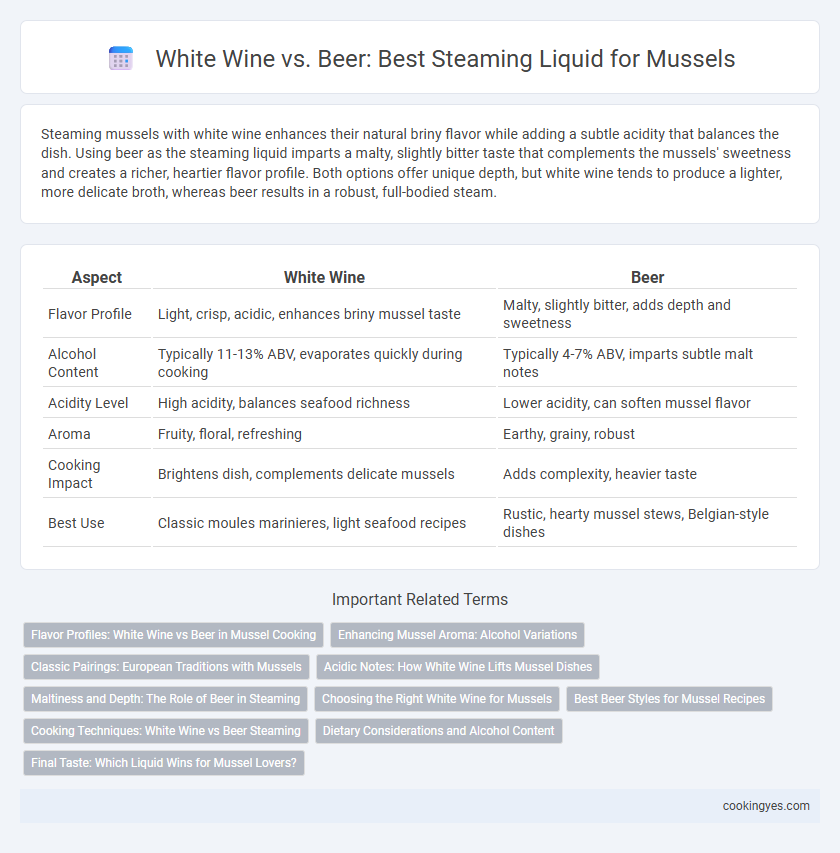Steaming mussels with white wine enhances their natural briny flavor while adding a subtle acidity that balances the dish. Using beer as the steaming liquid imparts a malty, slightly bitter taste that complements the mussels' sweetness and creates a richer, heartier flavor profile. Both options offer unique depth, but white wine tends to produce a lighter, more delicate broth, whereas beer results in a robust, full-bodied steam.
Table of Comparison
| Aspect | White Wine | Beer |
|---|---|---|
| Flavor Profile | Light, crisp, acidic, enhances briny mussel taste | Malty, slightly bitter, adds depth and sweetness |
| Alcohol Content | Typically 11-13% ABV, evaporates quickly during cooking | Typically 4-7% ABV, imparts subtle malt notes |
| Acidity Level | High acidity, balances seafood richness | Lower acidity, can soften mussel flavor |
| Aroma | Fruity, floral, refreshing | Earthy, grainy, robust |
| Cooking Impact | Brightens dish, complements delicate mussels | Adds complexity, heavier taste |
| Best Use | Classic moules marinieres, light seafood recipes | Rustic, hearty mussel stews, Belgian-style dishes |
Flavor Profiles: White Wine vs Beer in Mussel Cooking
White wine imparts a bright, acidic note with citrus and floral undertones that enhance the natural brininess of mussels, creating a clean and refined flavor profile. Beer contributes malty sweetness and subtle bitterness, adding depth and a slightly earthy character that complements the mussels' richness. Choosing white wine or beer for steaming influences the overall taste, with white wine offering crispness and beer providing a fuller, more robust flavor.
Enhancing Mussel Aroma: Alcohol Variations
Steaming mussels with white wine enhances their natural briny aroma through its fruity and acidic ethanol compounds, which help release and amplify the shellfish's delicate flavors. Beer, containing malt sugars and higher carbonation, imparts a subtle sweetness and earthy notes that create a richer, more robust aroma profile. The alcohol content in white wine also evaporates more quickly than beer, allowing for a cleaner, sharper musky scent that highlights the mussel's freshness.
Classic Pairings: European Traditions with Mussels
Classic European traditions favor white wine, especially dry varieties like Sauvignon Blanc or Muscadet, as the steaming liquid for mussels to enhance their delicate briny flavor. The wine's acidity complements the mussels' natural sweetness and helps open the shell, creating a light, aromatic broth integral to dishes like Moules Marinieres. In contrast, beer, commonly Belgian ales or lagers, lends a maltier, richer profile that pairs especially well with heartier mussel recipes typical in Northern European coastal regions.
Acidic Notes: How White Wine Lifts Mussel Dishes
White wine's higher acidity enhances mussel dishes by brightening the natural briny flavors and tenderizing the shellfish during steaming. The citrusy and tart notes from Sauvignon Blanc or Pinot Grigio elevate the mussels' taste, creating a balanced contrast to their mild sweetness. Beer, with its maltier and less acidic profile, offers a richer but heavier flavor that can overshadow the delicate texture of mussels.
Maltiness and Depth: The Role of Beer in Steaming
Beer imparts a rich maltiness and robust depth to mussels during steaming, enhancing their natural briny flavors with toasted, caramelized notes from the malt. Unlike white wine, which offers acidity and fruitiness, beer's complex malt profile intensifies the umami experience and adds a subtle sweetness that complements the shellfish. The carbonation in beer also helps to tenderize the mussels, making it a flavorful and effective steaming liquid choice for depth and richness.
Choosing the Right White Wine for Mussels
Choosing the right white wine for steaming mussels enhances their natural briny flavor and complements their delicate texture. Opt for a dry, crisp white wine such as Sauvignon Blanc, Pinot Grigio, or Muscadet, which offer bright acidity and citrus notes that balance the mussels' sweetness. Avoid overly oaky or buttery wines, as their heavy flavors can overwhelm the subtle taste of the seafood.
Best Beer Styles for Mussel Recipes
Belgian-style witbier and German-style hefeweizen excel as steaming liquids for mussel recipes, offering citrus and spice notes that complement the shellfish's briny flavors. Pilsners provide a clean, crisp base that enhances mussels without overpowering their natural taste. Using beer styles with balanced bitterness and moderate alcohol content ensures the broth remains flavorful and aromatic while tenderizing the mussels perfectly.
Cooking Techniques: White Wine vs Beer Steaming
Steaming mussels with white wine enhances the natural briny flavor while adding subtle acidity that balances richness, making it a preferred choice in classic French and Mediterranean recipes. Beer steaming imparts a malty sweetness and slight bitterness that complements the mussels' sweetness, commonly used in Belgian and Northern European cuisines. Both liquids contribute distinct flavor profiles and aromatics, requiring chefs to select based on desired taste complexity and regional cooking traditions.
Dietary Considerations and Alcohol Content
White wine is a popular choice for steaming mussels due to its lower calories and moderate alcohol content, typically around 12-14%, which can enhance flavor without overpowering the dish. Beer, especially lighter varieties like lagers or pilsners, offers a unique maltiness and often has a lower alcohol percentage, generally between 4-6%, making it a suitable alternative for those seeking reduced alcohol intake. From a dietary standpoint, white wine contains fewer carbohydrates compared to beer, which may be preferable for low-carb diets, while beer provides additional B vitamins derived from the brewing grains.
Final Taste: Which Liquid Wins for Mussel Lovers?
Steaming mussels in white wine enhances their natural brininess with subtle citrus and mineral notes, creating a clean, elegant final taste favored by seafood purists. Beer introduces a malty, slightly sweet complexity that deepens the mussels' flavor, often appealing to those who prefer a richer, heartier broth. For mussel lovers seeking a bright, fresh finish, white wine typically wins, while beer offers a robust alternative for a more savory experience.
White wine vs Beer for steaming liquid Infographic

 cookingyes.com
cookingyes.com